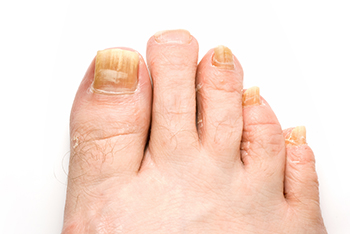
Fungal toenails form due to an infection of fungal organisms that gets in between either the cracks in the nail due to injury, under the nail due to friction and in the cuticle after pedicures for example. When this occurs, it’s likely to discolor and thicken the nail; this makes it hard to care for or trim. The nail itself may also become brittle and could potentially crumble. The fungus under the nail may build over time, separating the nail from the bed and ultimately causing it to fall off if not treated properly.
Fungal nails typically form due to the lack of footwear in public, warm, damp environments. Popular areas where patients have picked up a fungal infection include communal showers, locker rooms, gyms, and swimming pools and pedicures. If you’re prone to sweaty feet, you may be more likely to develop a fungal nail as well. You may also be more likely to develop a fungal nail if you have a weaker immune system or have a history with athlete’s foot.
For a proper diagnosis and advised treatment plan, it’s recommended that you consult with a podiatrist as soon as possible for professional care and to prevent the infection from spreading.
Condition:
Onychomycosis is a fungal infection of the toenails or fingernails. Half of all nail disorders are caused by onychomycosis, and it is the most common nail disease in adults. Toenails are much more likely to be infected than fingernails. The incidence of onychomycosis has been increasing and is related to diabetes, a suppressed immune system and increasing age.
Symptoms:
Onychomycosis causes fingernails or toenails to thicken, discolor, disfigure and split. At first, onychomycosis appears to be only a cosmetic concern, but without treatment, the toenails can become so thick that they press against the inside of the shoes, causing pressure, irritation and pain.
Treatment:
May Include - FIRST confirm diagnosis with fungal stain or other testing sent to a lab by taking a nail clipping.
- Oral or topical medication
- Reduction of nails regularly
- Surgical removal of nails sometimes is necessary either temporarily or permanently.
Fungal nails refer to any number of fungal nail infections that can occur on the foot. Since fungal nails are usually more resistant and more difficult to treat than athlete’s foot, topical or oral antifungal medications may be prescribed.
Note: Please consult a physician before taking any medications. Permanent nail removal is another possible form of treatment for tenacious fungal nails.
Prevention:
- Don’t share nail clippers or nail files with others. (includes pedicures)
- Don’t share shoes or socks with others.
- Spray carpet/rugs of high traffic areas with Lysol, spray inside of shoes with Lysol and allow it to dry overnight.
- Dispose all old nail polish.
- Clean your tub/shower after each use to prevent re-infection.
- Try not to injure your nail, such as by cutting it too short (trauma to the nail may lead to infections).
- Wear dry cotton socks.
- Some people benefit from wearing shower sandals or shower shoes when you are at a public pool.
- Don’t Wait to Treat Your Toenail Fungus
Tuscany Podiatry in Tuscaloosa, AL, has the specialty treatment for you.
If you’re suffering from onychomycosis, don’t wait to call our expert Tuscaloosa, AL, foot doctors at Tuscany Podiatry. Toenail fungus can cause serious medical problems for some people with weakened immune system that go beyond simple cosmetic issues. Onychomycosis causes your toenails to become discolored and thick which results in discomfort and pressure from your shoes.
At Tuscany Podiatry in Tuscaloosa, AL, we have the best treatment available through our Class IV laser treatment. This FDA-indicated machine eliminates unsightly nail fungus caused by onychomycosis. The laser light passes through the toenail and, without damaging the skin or nails, destroys the infection and allows new collagen to form.
When you come to Tuscany Podiatry to have your toenail fungus treated, a specimen will be taken to confirm you have onychomycosis. After your results come in, which typically takes one week, we will discuss the findings and, if toenail fungus is found, you can schedule your first laser treatment.
On your first day of treatment, your toenails will be cleaned prior to any laser treatment. You may feel a mild warming sensation as each toe is being treated but afterward, you will feel no discomfort. Laser treatments typically last under 10 minutes and you will notice results in about two to four months, depending on how quickly your toenails grow.
For expert podiatry from our exceptional foot doctors, call Tuscany Podiatry at (659) 228-9557. For 20 years, we have been providing quality foot care to the Tuscaloosa, AL, area.



